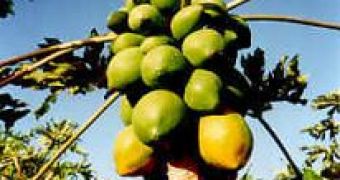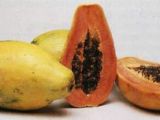Papaya is the fruit of the tree Carica papaya.
The 5-10 m tall unbranched tree has a cluster of large leaves (till 70 cm in diameter) on the top of its unbranched stem. The lower trunk is punctuated by the scars left by older leaves and fruits. The beautiful white flowers grow at the base of the leaves and a mature papaya fruit can reach 45 cm length and 30 cm width.
Thus, the orange to amber hued fruits grow directly on the stem. They are juicy and their smooth skin is thick. Papaya originated in Central America and currently is found only in cultures, being now cultivated worldwide at the tropics till India, South Africa and the Philippines. The fruit is sweet, but many will notice a resinous flavor, like the smell of the coniferous tree.
Papaya is usually eaten raw, without the skin or seeds, sole or with salt, black pepper or lemon. Papaya syrup is sedative and tonic. The unripe green papaya can be served cooked in curries, salads and stews.
Papaya contains a digestive enzyme called papain that breaks down proteins, that's why papaya is used for tenderizing and digesting meats and other protein-rich aliments.
This quality is used for millennia by native Amerindians for breaking down the tough meat fibers and papain is also found in the papaya tree's leaves, which in Asia, picked up young, are steamed and eaten like spinach.
Powder meat tenderizers and digestive pills are made from papaya. The fruit but especially the black seeds contain an anthelmintic (against intestinal worms) alkaloid named carpaine, but too high doses won't kill only the worms ...
They are edible, possessing a sharp, spicy taste and can be ground up, replacing black pepper. The flesh of the fruit is used against freckles. The latex of the tree causes irritation and provokes allergic reaction in some people, but it is used against moles. The tree's roots are used for strengthening the nervous system.
In Pakistan, India, Sri Lanka and Southeast Asia papaya has been being used for long as a traditional remedy for contraception and abortion.
These qualities were confirmed by scientific research and were found at least in monkeys very effective in male contraception as well. The unripe fruit contains even more phytochemicals, which stop the progesterone activity. Papaya does not provoke malformations and will not cause abort in small, ripe amounts. Genetically engineered strains present low doses of these phytochemicals.
In South America there are many other wild species of papaya, with smaller fruits.

 14 DAY TRIAL //
14 DAY TRIAL // 
